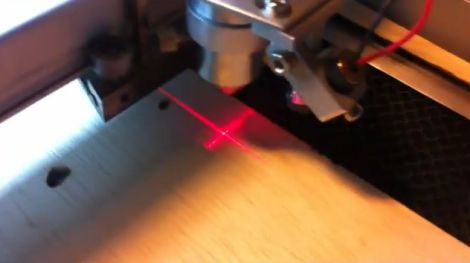
[Rich] was having quite a bit of fun with his newly-acquired laser cutter, but was not impressed by the stock aiming laser that came with it. The problem with the built-in laser is that it did not actually follow the cutting laser’s path – instead, it has to be calibrated for a fixed focal length. This becomes problematic when engraving and cutting since they require different focal lengths, so it becomes a guessing game as to where the cutting laser will actually end up in respect to the aiming laser.
An additional optic module that solves this problem can be had for about $300, but after sinking $2500 into the laser setup, [Rich] was not inclined to purchase one. Instead, he bought a pair of cheap laser levels online and scavenged the line lens from one module, which was mounted on the laser cutter’s existing aiming laser. The second module was epoxied to the top of the cutting head, to create a set of cross hairs on the work surface.
As you can see in the video below, the hack works quite well, and the lasers are accurate at a variety of different focal lengths.
[youtube=http://www.youtube.com/watch?v=IAcZ7tL-ZpY&w=470]















Nice job. Cleverly solved! The FSLaser guys should incorporate this fix in their design.
Fairly clever way to deal with varying focal lengths. I knife-edged a second beam on my laser cutter which is more like the typical solution except with a mirror instead of a beam combiner.
What is that thing at the end credits??
Cutting and engraving done at different focal lengths?
Huh?
I used a ZnSe beam combiner off ebay. New, $100, includes laser diode. Makes mirror alignment so much easier.
@DMCBEING – Cloud chamber. Go to their website and check it out.
Lasers don’t need to be focused. That’s the whole point.
Anyway, you can make a ‘line lens’ with some acrylic or glass rod. Try shining a laser pointer through a wineglass stem and you’ll see what I mean.
great invention
You are right in that laser light is coherent and doesn’t disperse nearly as much as regular light. But the principal of focusing light to focus more energy on a smaller area is the same.
So basically it’s more cutting power. That and maybe the kerf is different without it and you want a specific width of your line.
DealExtreme will sell you laser line modules for a few dollars.
This is not exactly a new concept, I’ve had this on my milling machine for ages, and it adding it to my laser was a no-brainer.
@macona, huh? from here too about engraving & cutting at different depths.
Using the cross-hairs is useful when you have a z-axis. If you have a dot laser on the head it’s only accurate when the bed height is correct (matches focal length), as the summary points out. At the wrong height the aiming laser & the cutting beams will be at two diferent spots.
The trick is to have both, the line lasers show where the beam will go, and when the dot laser overlaps the cross-hair, then your depth is correct.
The ‘correct’ way to do it is with a beam combiner, and yes they are expensive. Mounting a dot laser on the cutting heat isn’t accurate.
$300 ???
A few weeks ago I bought the components to add this to my BuildLog 2.x laser cutter. I found laser line units on ebay 5 for $20 (search “laser line”). Once I finish the laser I plan on using it to cut the acrylic mount. So it should cost me less than $30 to do the same thing.
http://www.buildlog.net/blog/2011/02/buildlog-net-2-x-laser/
Ahhh… When I first read the article I though he did spend the $300. Anyway I am going to avoid the epoxy and plan on using shaft collars mounted to a laser cut piece acrylic that fits over the lens holder. This way it will be adjustable.
@Awesomenesser, the $300 is for a beam combiner.
See http://www.genuineholographics.com/BeamCombiner.html.
With this the IR & visible red light travel on the same path, so you don’t need the line lasers on the head, and where the red goes the IR is guaranteed to go there too.
And yes, considering you can buy the full optics for half that, $300 is expensive for a fancy mirror.
hey – it’s Rich / nothinglabs.com (creator of is hqck)
so – the reason you set focus differently for engraving and cutting is that you want the laser to be focused most tightly on the surface for engraving (smallest dot size) and in the middle (inside piece) with cutting to take advantage of relatively tight focus both above and below the actual focal point.
(yes – the lens’s focal length actually stays the same – but you know what I mean)
and definitely check out the cloud chamber (the video is showing alpha particles from radioactive lead) – you can buy one from me – or there are instuctions to make your own for $100 or so (look on nothinglabs.com for the link to the “homebrew” version)